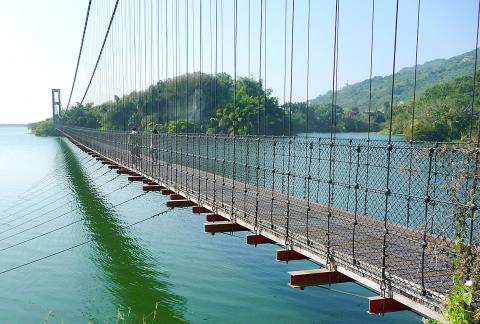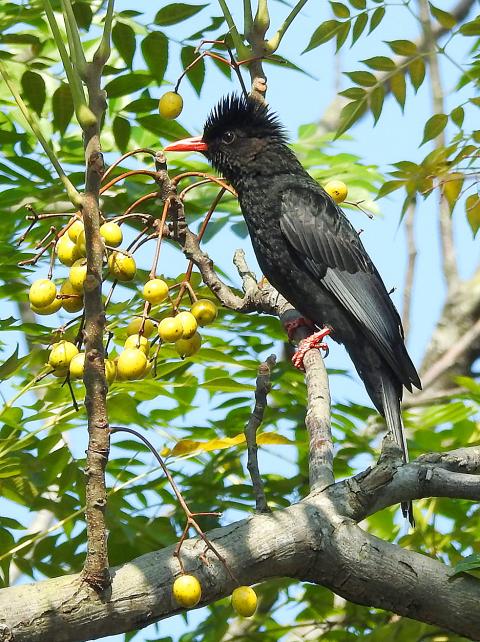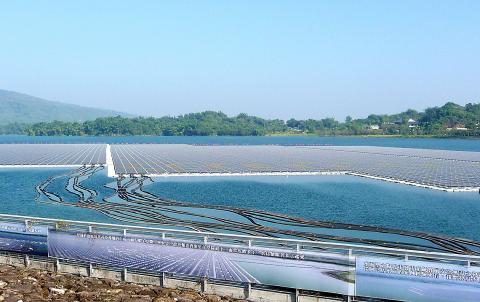Twice in the last fortnight I’ve been to Kaohsiung’s Agongdian Reservoir (阿公店水庫), and not just because it’s a toponym I adore. The literal meaning of Agongdian (阿公店) is “grandpa’s shop,” although it seems this place name never referred to a silver-haired shopkeeper’s place of business.
The first human inhabitants of this part of Kaohsiung called the area Agongtoan. The Fujianese migrants who arrived in the 17th century changed the pronunciation to “A-kong tiam,” and applied it to both the town now known as Gangshan (岡山) and the stream called Agongdian Creek (阿公店溪).
On my second and much more relaxed visit, I rode my bike around the reservoir’s 6.82-km-long cycling trail and took a closer look at the arrays of photovoltaic panels that have been installed on the surface of the water. If this floating power station, which was set up in 2017, is expanded as planned, it’ll soon be producing enough clean electricity to meet the needs of well over 4,000 households. The arrays cover the southeastern quarter of the reservoir, and are clearly visible in satellite photos.

Photo: Steven Crook
Agongdian Creek was dammed in the early 1950s to create a reservoir with a surface area of 410 hectares. The project had been initiated by the Japanese colonial authorities in 1942, but work was suspended after flooding damaged the site. Once the dust of World War II and the Chinese Nationalist Party’s (KMT) retreat to Taiwan had settled, work proceeded rapidly. The 2.38-km-long barrier was completed in August 1953.
Before the reservoir became a source of renewable energy, most of the environmental news it generated was bad. For many years, it was blighted by eutrophication and other water-quality problems. A 2009 survey of 59 reservoirs in Taiwan found Agongdian to be among the five worst affected.
The authorities have stressed that the reservoir supplies farms and industry, not households, but this isn’t entirely reassuring. When so much of the water is used by farmers or food-processing companies, what’s to stop whatever’s tainting it from ending up in our food?

Photo: Steven Crook
Eutrophication is caused by an excess of nutrients in a pond or lake that causes a build-up of algae and other plant life which then prevents light and oxygen from entering the water. Almost always, the nutrients arrive in the form of fertilizer runoff from surrounding farmland. In the case of Agongdian Reservoir, an estimated 32 percent of its catchment area is devoted to orchards.
Water samples have also frequently detected glyphosate, an herbicide. One 2017 study noticed that the occurrence of glyphosate was much higher in summertime than in the spring, matching local agricultural practices. During my circumnavigation by bike, I saw fruit trees so close to the reservoir that, if the wind blew a certain way while the farmer sprayed, residues would immediately go into the water.
The authorities claim the situation is now much better. A bilingual information panel I came across on top of the dam soon after I began my anti-clockwise circuit says, “The water quality... has been improved dramatically by drawing in clean water from Cishan Creek (旗山溪). The mirror-clean and lustrous lake and neighboring Big Gangshan (大岡山) and Little Gangshan (小岡山) together have composed a great masterpiece of art.”

Photo: Steven Crook
I’m not sure I’d go that far, but the view from the barrier is pretty. If it’s a sunny day — here in the south, few days aren’t — going all the way around the reservoir is well worth it. If you haven’t arrived by bicycle, and don’t want to rent a share bike, join the locals who jog or hike all the way around. The northern part of the trail has some gradients, but they won’t slow you down by much.
Three minor sights can be seen from the base of the grass-covered dam. One is the well-kept Agongdian Forest Park (阿公店森林公園), which has an artificial creek to boost biodiversity, and a playground, but few actual trees. That said, there’s an impressive Samanea saman and a hefty American mahogany that looks far older than it is (40-odd years, according to a sign).
Looking westward to a tree-covered ridge, I got a clear view of Siaogangshan Skywalk (崗山之眼, open Tuesday to Friday from 9am to 6pm; admission NT$100 including shuttle bus). The third point of interest is the Merit People’s Livelihood Monument (功濟民生碑), an elegant sandstone stele commemorating the dam’s completion.

Photo: Steven Crook
Moving to the southern end of the dam, I came to Agongdian Reservoir Scenic Area Management Office (阿公店水庫風景區管理處). Not content with building one of Taiwan’s largest solar arrays on the water, the authorities have covered the roof of every building here with additional PV units. Most of the parking spots are shaded by solar cells, and there are even more panels atop the adjacent army base.
I pushed my bike across the 243-meter-long Risheng Penglai Suspension Bridge (日昇蓬萊吊橋) and worked my way northward along the reservoir’s eastern shore. After about 2km, the trail climbed into thick bamboo forest, reemerging at Yanpo Suspension Bridge (煙波吊橋, 405m long). This is my favorite part of the reservoir. You can hear birdsong because there’s no traffic within earshot, and if I had to sum up the scenery in two words, I’d say: tropical fjords.
Steven Crook has been writing about travel, culture, and business in Taiwan since 1996. He is the co-author of A Culinary History of Taipei: Beyond Pork and Ponlai, and author of Taiwan: The Bradt Travel Guide, the third edition of which has just been published.

Photo: Steven Crook

This month the government ordered a one-year block of Xiaohongshu (小紅書) or Rednote, a Chinese social media platform with more than 3 million users in Taiwan. The government pointed to widespread fraud activity on the platform, along with cybersecurity failures. Officials said that they had reached out to the company and asked it to change. However, they received no response. The pro-China parties, the Chinese Nationalist Party (KMT) and Taiwan People’s Party (TPP), immediately swung into action, denouncing the ban as an attack on free speech. This “free speech” claim was then echoed by the People’s Republic of China (PRC),

Exceptions to the rule are sometimes revealing. For a brief few years, there was an emerging ideological split between the Democratic Progressive Party (DPP) and Chinese Nationalist Party (KMT) that appeared to be pushing the DPP in a direction that would be considered more liberal, and the KMT more conservative. In the previous column, “The KMT-DPP’s bureaucrat-led developmental state” (Dec. 11, page 12), we examined how Taiwan’s democratic system developed, and how both the two main parties largely accepted a similar consensus on how Taiwan should be run domestically and did not split along the left-right lines more familiar in

As I finally slid into the warm embrace of the hot, clifftop pool, it was a serene moment of reflection. The sound of the river reflected off the cave walls, the white of our camping lights reflected off the dark, shimmering surface of the water, and I reflected on how fortunate I was to be here. After all, the beautiful walk through narrow canyons that had brought us here had been inaccessible for five years — and will be again soon. The day had started at the Huisun Forest Area (惠蓀林場), at the end of Nantou County Route 80, north and east

Specialty sandwiches loaded with the contents of an entire charcuterie board, overflowing with sauces, creams and all manner of creative add-ons, is perhaps one of the biggest global food trends of this year. From London to New York, lines form down the block for mortadella, burrata, pistachio and more stuffed between slices of fresh sourdough, rye or focaccia. To try the trend in Taipei, Munchies Mafia is for sure the spot — could this be the best sandwich in town? Carlos from Spain and Sergio from Mexico opened this spot just seven months ago. The two met working in the